
Eupithecia is a large genus of moths of the family Geometridae. There are hundreds of described species, found in all parts of the world, and new species are discovered on a regular basis.

The lime-speck pug is a moth of the family Geometridae. It is a common species throughout the Palearctic region, the Near East and North Africa.

The common pug(Eupithecia vulgata) is a moth of the family Geometridae. It is a common species across the Palearctic region, the Near East and North Africa. It ranges from the Atlantic coast of Ireland and Portugal across Europe, the Middle East and Central Asia to the Russian Far East (Priamurje) and Korea.

The juniper pug or juniper looper(Eupithecia pusillata) is a moth of the family Geometridae. It is found throughout the Palearctic and Nearctic regions and the Near East.
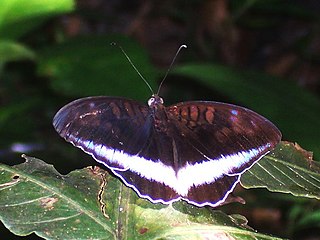
The Limenitidinae are a subfamily of butterflies that includes the admirals and relatives. The common names of many species and genera reference military ranks or – namely the Adoliadini – titles of nobility, in reference to these butterflies' large size, bold patterns, and dashing flight. In particular, the light stripe running lengthwise across the wings of many Limenitidini has reminded earlier authors of officers' shoulder marks and epaulets.

Adelpha californica, the California sister, is a species of butterfly in the family Nymphalidae. They are common in California, but can also be found in western Nevada and Oregon, as well as in northern Baja California. The upper surfaces of their wings are dark brown to black with wide cream white bands dissecting both wings and two orange patches near the tips of the forewings. The underside is variously colored with browns, blue, orange, and white. A. californica is unpalatable to predators and is part of a large mimicry complex.

Adelpha fessonia, the band-celled sister or Mexican sister, is a species of butterfly of the family Nymphalidae. It is found in Panama north through Central America to Mexico. It is a periodic resident in the lower Rio Grande Valley, Texas.

Eupithecia venosata, the netted pug, is a moth of the family Geometridae. It was first described by Johan Christian Fabricius in 1787. It is found across the Palearctic ecozone from Portugal and Morocco in the west to the Lake Baikal in Siberia and Afghanistan and Pakistan in the east.

Adelpha is a genus of brush-footed butterflies found from the southern United States and Mexico to South America. They are commonly known as sisters, due to the white markings on their wings, which resemble a nun's habit. This genus is sometimes included with the admiral butterflies (Limenitis).
Adelpha bredowii, the Bredow's sister, is a species of butterfly in the family Nymphalidae. It is endemic to western, central, and southern Mexico. Adelpha bredowii belongs to the serpa species group in the genus Adelpha (sisters). Adelpha bredowii previously included two subspecies, the California sister and the Arizona sister. Recent phylogenetic studies, however, conclude that morphological, geographical, and genetic evidence make it clear that these are correctly separate species. They have been reclassified as the species Adelpha californica and Adelpha eulalia, respectively.
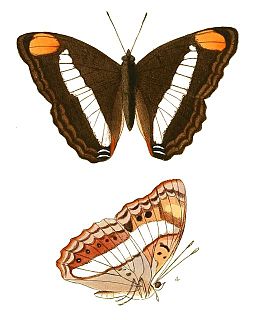
Doxocopa pavon, the Pavon emperor or Pavon, is a species of butterfly in the family Nymphalidae. They can be found from Paraguay in South America up to Texas in the southern United States. They are generally brown in their overall coloration, with two bands of white straddling the middle of the upper surfaces of the wings, and a patch of orange on the tips of their forewings. The upper surfaces of the wings of the males are overlaid by an iridescent blue-purple sheen. The females of the species closely resemble members of the unrelated genus Adelpha.

Adelpha eulalia, the Arizona sister, is a species of butterfly in the family Nymphalidae. It occurs from at least Guatemala and Mexico to the southwestern United States, including southeastern California, Arizona, New Mexico, and southern Texas. They can also sometimes be found in Oklahoma, Kansas, Colorado, Utah, and Nevada.
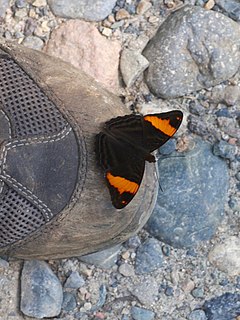
Adelpha boreas, the gaudy sister or solitary sister, is a butterfly of the family Nymphalidae. It was described by Arthur Gardiner Butler in 1866. It is found from Costa Rica to Bolivia. The habitat consists of primary and disturbed rainforests and cloudforests at altitudes between 200 and 1,200 meters.
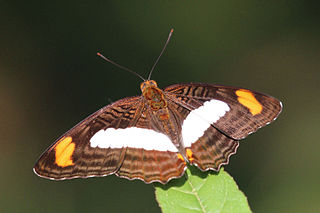
Adelpha iphiclus, the Iphiclus sister, is a butterfly of the family Nymphalidae. It was described by Carl Linnaeus in his 1758 10th edition of Systema Naturae. It is found in the tropics and sub-tropics of Central and South America, from Mexico to Bolivia. The habitat consists of disturbed areas in deciduous and evergreen forests at altitudes ranging from 0 to 1,200 meters.
Adelpha nea, the Nea sister, is a butterfly of the family Nymphalidae. It was described by William Chapman Hewitson in 1847. It is found from south-eastern Mexico, Belize and Costa Rica to Venezuela and southern Peru, the Guianas and Amazonian Brazil.

Adelpha erotia, the Erotia sister, is a butterfly of the family Nymphalidae. It was described by William Chapman Hewitson in 1847.
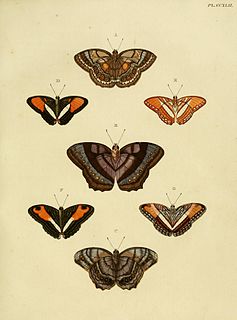
Adelpha cocala, the cocala sister or orange-washed sister, is a butterfly of the family Nymphalidae. It was described by Pieter Cramer in 1779. It is found from Honduras to Panama, Guatemala, Venezuela, Colombia, Surinam, Peru, Bolivia and Brazil.
Chrysobothris adelpha is a species of metallic wood-boring beetle in the family Buprestidae. It is found in North America.
Adelpha basiloides, the spot-celled sister, is a species of admirals, sisters in the family of butterflies known as Nymphalidae. It is found in North America.















